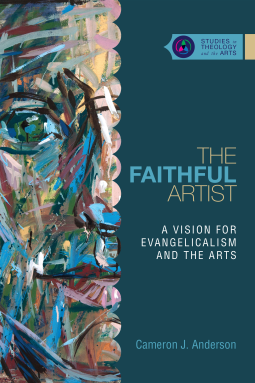Please wait... This may take a moment.
The Faithful Artist
A Vision for Evangelicalism and the Arts
This title was previously available on NetGalley and is now archived.
Pub Date
Nov 07 2016
| Archive Date
Dec 28 2016
Description
In this latest volume in IVP Academic’s
Studies in Theology and the Arts series, Cameron Anderson lays out a vision for
how Christian artists can faithfully pursue their vocational calling in
contemporary culture.
Drawing on his experiences as both a Christian and a practicing artist, Anderson traces the relationship between evangelicalism and modern art in postwar America—two entities that often found themselves at odds with each other. With skill, sensitivity and insight, he considers the role of our bodies and our senses in our experience of the arts, the relationship between text and image, the persistent dangers of idolatry, the possibility of pursuing God through an encounter with beauty, and more. Readers will find here not only informed and thoughtful responses, but also a vision that offers guidance and hope, dispelling the false choice between Christianity and the arts.
In this latest volume in IVP Academic’s
Studies in Theology and the Arts series, Cameron Anderson lays out a vision for how Christian artists can faithfully pursue their vocational calling in...
Description
In this latest volume in IVP Academic’s
Studies in Theology and the Arts series, Cameron Anderson lays out a vision for
how Christian artists can faithfully pursue their vocational calling in
contemporary culture.
Drawing on his experiences as both a Christian and a practicing artist, Anderson traces the relationship between evangelicalism and modern art in postwar America—two entities that often found themselves at odds with each other. With skill, sensitivity and insight, he considers the role of our bodies and our senses in our experience of the arts, the relationship between text and image, the persistent dangers of idolatry, the possibility of pursuing God through an encounter with beauty, and more. Readers will find here not only informed and thoughtful responses, but also a vision that offers guidance and hope, dispelling the false choice between Christianity and the arts.
Advance Praise
"Anderson . . . clarifies for Christians why art still matters in the
midst of tensions between traditional religious belief and modern
aesthetic sensibility—issuing a compelling call for artists to
rediscover their accountability and calling within the body of Christ,
broken afresh for the life of the world. Additionally he makes a vital
argument for why the church needs art and artists, providing genuine
answers for how these might once again find their way into healthy
communion with one another."
—Bruce Herman, Lothlorien Distinguished Chair in Fine Arts, Gordon College
"This is a thoughtful, remarkable book that will help evangelical
Christians face their history of shunning modern art. As a convinced
follower of Jesus Christ, Anderson lovingly laments the past evangelical
practice of pitting binary opposites against one another: soul against
body, word against image, church ministry against being an artist.
Anderson shows how the millennia of church history and a fresh biblical
stance can overcome these polarities. Through his writing, which is
extremely well researched and gives evidence of many years of wide
reading, he convincingly shows how visual culture can be central to
piety and how artistry is a worthy occupation for believers. This work
is exciting, people friendly, deeply faithful and wise."
—Calvin Seerveld, professor emeritus of philosophical aesthetics, Institute for Christian Studies, Toronto
"Cam Anderson's vision inspires, challenges and encourages me. He is
wise about creativity, faithful about imagination and provocative about
beauty. We are invited into a deeper humanity and a greater faithfulness
to the Artist who made us. I am so grateful for this book and believe
many other readers will be too!"
—Mark Labberton, president, Fuller Theological Seminary
"Anderson . . . clarifies for Christians why art still matters in the midst of tensions between traditional religious belief and modern aesthetic sensibility—issuing a compelling call for artists...
Advance Praise
"Anderson . . . clarifies for Christians why art still matters in the
midst of tensions between traditional religious belief and modern
aesthetic sensibility—issuing a compelling call for artists to
rediscover their accountability and calling within the body of Christ,
broken afresh for the life of the world. Additionally he makes a vital
argument for why the church needs art and artists, providing genuine
answers for how these might once again find their way into healthy
communion with one another."
—Bruce Herman, Lothlorien Distinguished Chair in Fine Arts, Gordon College
"This is a thoughtful, remarkable book that will help evangelical
Christians face their history of shunning modern art. As a convinced
follower of Jesus Christ, Anderson lovingly laments the past evangelical
practice of pitting binary opposites against one another: soul against
body, word against image, church ministry against being an artist.
Anderson shows how the millennia of church history and a fresh biblical
stance can overcome these polarities. Through his writing, which is
extremely well researched and gives evidence of many years of wide
reading, he convincingly shows how visual culture can be central to
piety and how artistry is a worthy occupation for believers. This work
is exciting, people friendly, deeply faithful and wise."
—Calvin Seerveld, professor emeritus of philosophical aesthetics, Institute for Christian Studies, Toronto
"Cam Anderson's vision inspires, challenges and encourages me. He is
wise about creativity, faithful about imagination and provocative about
beauty. We are invited into a deeper humanity and a greater faithfulness
to the Artist who made us. I am so grateful for this book and believe
many other readers will be too!"
—Mark Labberton, president, Fuller Theological Seminary
Available Editions
| EDITION |
Paperback |
| ISBN |
9780830850648 |
| PRICE |
$26.00 (USD)
|
| PAGES |
290
|
Additional Information
Available Editions
| EDITION |
Paperback |
| ISBN |
9780830850648 |
| PRICE |
$26.00 (USD)
|
| PAGES |
290
|
Average rating from 3 members




